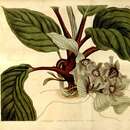en
names in breadcrumbs


Tacca integrifolia, the white batflower or black lily,[2] is a species of flowering plant in the yam family of Dioscoreaceae. It is native to tropical and subtropical rainforests in hilly regions of South Asia from Pakistan to Bangladesh, Indochina, Malay Peninsular, Sumatra, Java and eastern China.[3]: 389 [4]
It grows in the understorey of humid primary and secondary rainforests, growing in the leaf litter in shady sites.[5][3]: 391 It also grows in sandy or rocky soils.[3]: 391
Tacca integrifolia is a herb growing from a thick, cylindrical rhizome as long as 12 cm (5 in) and a diameter of 3 cm (1 in). Its oblong-elliptical or lanceolate leaf blades are borne on long stems, some 50 by 20 cm (20 by 8 in) including the petioles, with tapering bases and slender pointed tips. White batflowers that grow in hilly areas are larger in size than batflowers that grow elsewhere.[4][6][2][3]: 390, 391
The flower scape is about 55 cm (22 in) long and is topped with a pair of involucral bracts, broad and erect, white with mauve venation. Among the individual nodding flowers, which are arranged in an umbel, are further long, filiform (thread-like) bracts. The perianth of each flower is tubular and purplish-black, 1 to 2 cm (0.4 to 0.8 in) long, with two whorls of three perianth lobes, the outer three narrowly oblong 12–15 cm (5–6 in) long and the inner three broadly obovate.[4][2]
The fruits are fleshy berries some 2 cm (0.8 in) long, and the seeds, which have six longitudinal ridges, have the remains of the perianth lobes still attached.[4]
The stamens are attached to the tube of the perianth in a helmet-like manner and, with the flat-topped stigma lobes, may form an insect trap; a sweet musky odour has been detected from these flowers and this may attract flies as pollinators. After pollination, the scape bends over and the developing fruits rest on the ground. The fleshy fruits are a dull colour with soft jelly-like pulp, and it is possible that the seeds are dispersed by rodents and other small mammals as they feed on the fruits.[6]
In the Malay Peninsula, its leaves are dried to make cigarette wrappers.[3]: 391
Tacca integrifolia, the white batflower or black lily, is a species of flowering plant in the yam family of Dioscoreaceae. It is native to tropical and subtropical rainforests in hilly regions of South Asia from Pakistan to Bangladesh, Indochina, Malay Peninsular, Sumatra, Java and eastern China.: 389